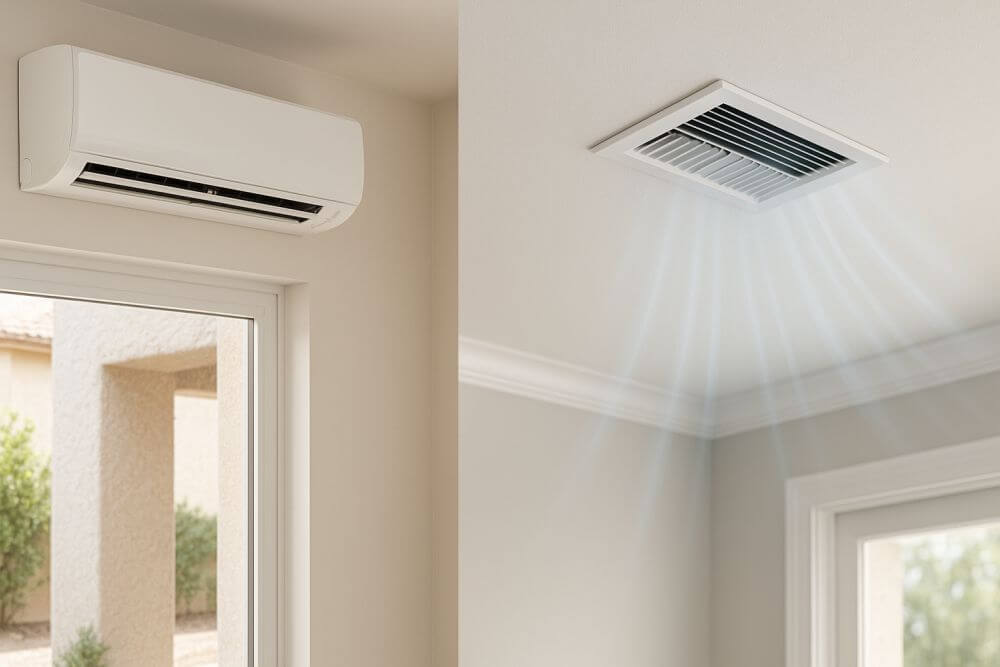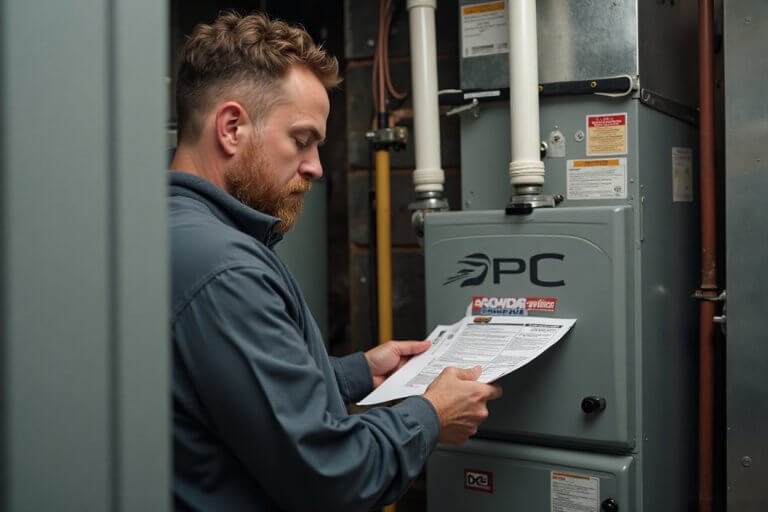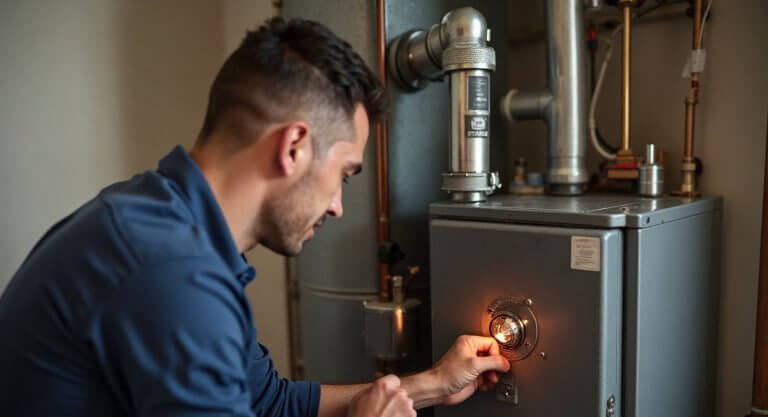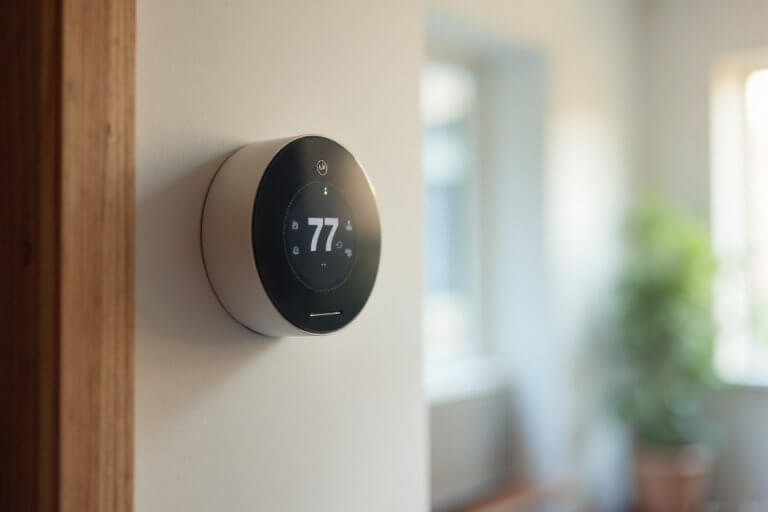When comparing ductless mini splits vs central air, the pros and cons depend on your home’s layout, budget, and comfort priorities. Mini splits are more efficient and flexible, while central air conditioning provides whole-home cooling with a single system.
In this guide, we’ll break down mini splits vs central air pros and cons to help you decide which one is the best choice for your LA home. For personalized guidance, contact Season Control Heating & Air Conditioning at (818) 275-8487.
What is a Ductless Mini Split System?
A ductless mini split system is an HVAC unit that cools (and often heats) your home without using ductwork. It consists of two main parts: an outdoor compressor and one or more indoor air handlers that are typically mounted high on a wall. Each indoor unit controls the temperature of a single room or zone, giving you the flexibility to cool only the spaces you use most.
Mini splits are popular in Los Angeles homes without existing ducts, room additions, garages, or areas where running ductwork isn’t practical.
What is a Central Air Conditioning System?
A central air conditioning system uses a network of ducts to cool your entire home from one central unit. The system pulls warm air from inside, cools it using a refrigerant and a heat exchanger, then distributes the cooled air through ducts and vents in each room.
Central AC is a common choice in Los Angeles homes that already have ductwork in place. They are popular for their ability to deliver consistent temperatures throughout the entire house while keeping all the equipment concealed.
Pros of Mini Split Systems
Energy Efficiency
Ductless mini splits prevent the energy losses that come with ductwork, which can account for 20–30% of cooling costs in traditional central AC. In Los Angeles, where AC systems often run long hours during summer heatwaves, that efficiency translates into noticeably lower utility bills.
Zoned Comfort
Each indoor unit cools a single room or zone, letting you customize temperatures according to different cooling needs. This zoning prevents wasted energy and arguments over the thermostat. It’s also ideal for home offices or guest rooms that aren’t used every day.
Flexible Installation
Because mini splits don’t need ducts, they’re ideal for older Los Angeles homes, ADUs (accessory dwelling units), or garage conversions where adding ductwork would be costly or disruptive. The installation process is quicker, with only a small wall opening needed to connect the indoor and outdoor units.
Cons of Ductless Mini Splits
Higher Upfront Cost per Room
While a single mini split is affordable, installing multiple units in your LA home can quickly exceed the cost of installing one central AC system. Each additional room requires its own indoor unit, which adds to equipment and installation expenses. This makes mini splits less budget-friendly for larger homes.
Aesthetic Concerns
Mini split units are mounted on the wall, and not everyone loves the look. In Los Angeles homes, a visible unit in the living room or bedroom can feel out of place. Central air, by contrast, keeps everything tucked away behind ducts and vents, making it the more discreet option.
Maintenance for Each Unit
Every ductless air conditioning unit has its own filter that needs to be cleaned or replaced regularly. In a Los Angeles home with four or five units, this can add up to extra time and effort compared to changing a single filter in a central system.
Pros of Central Air Conditioner
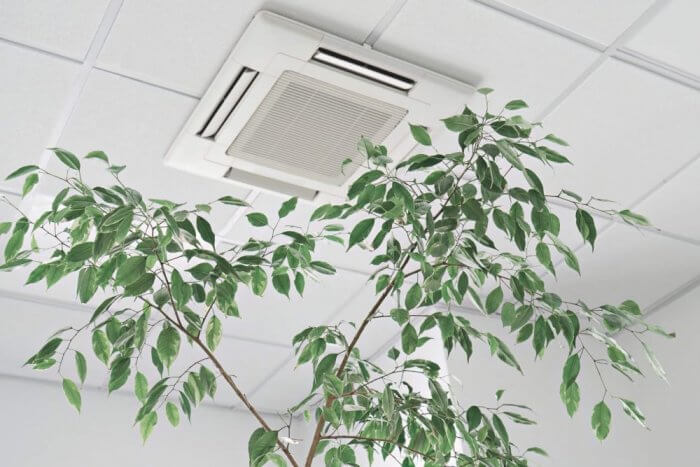
Whole-Home Comfort
Central air systems cool your entire house with one single unit. This keeps temperatures consistent in every room of the house and is often more practical than installing several mini split units.
Discreet Design
Unlike mini splits, which mount visibly on walls, central AC systems stay hidden behind ducts and vents. In LA homes where modern design and clean aesthetics matter, this makes the central air system the preferred option. You get reliable cooling without altering the look of your living spaces.
Smart Thermostat Compatibility
You can pair most central air conditioning systems with smart thermostats that make managing comfort simple and efficient. This allows you to program cooling schedules, control the system remotely, and monitor usage to save money.
Added Resale Value
Homes with central air conditioners are often more attractive to buyers. In competitive Los Angeles real estate markets, central AC can be seen as a standard expectation and may help your property stand out when it’s time to sell.
Cons of Central Air Conditioning Systems
Energy Loss Through Ducts
Central AC relies on ductwork to move cool air, but ducts often develop leaks or lose efficiency over time. In Los Angeles homes with older duct systems, this can mean higher energy bills since cooled air escapes before reaching each room.
Higher Installation Costs Without Existing Ducts
Many older LA homes were built without ducts, which means adding them could involve opening up walls or ceilings. If your home doesn’t already have ductwork, installing a central AC system can be a major project with a significant installation cost.
Less Flexible Cooling
Central AC cools the entire home whenever it runs, even if you only need cooling in one or two rooms. If your family spends more time in certain areas (like a home office or living room), this can mean wasted energy compared to the room-by-room control of mini splits.
Split AC vs Central AC Cost
The cost difference between split systems and central air conditioning systems depends on your home’s layout. Ductless mini splits are usually cheaper if you don’t have ductwork, but outfitting an entire house with multiple units can quickly get expensive. Central air conditioners are more cost-effective in homes that already have ducts, though adding new ductwork can increase
Central AC vs Split AC Power Consumption
Mini splits have lower power consumption because they don’t lose cooled air through ducts and let you target only the rooms you’re using. A central HVAC system, on the other hand, cools the whole home every time it runs, which often leads to higher electricity use during Los Angeles’ long, hot summers.
Central vs Ductless Air Conditioning Maintenance
Mini splits have multiple indoor units, each with its own filter that needs to be cleaned or replaced. Central AC has a single main unit. However, its ducts require periodic cleaning and sealing, especially with dust and wildfire smoke common in the area.
Ductless AC Unit vs Central Air System Lifespan
Both ductless and central air conditioning systems can last 10–20 years with proper care, but their durability depends on usage and upkeep. Ductless mini-splits often last longer because they avoid duct-related wear and tear. Central AC systems are reliable for whole-home cooling, but duct issues or poor maintenance can shorten their lifespan.
Split Air Conditioner vs Central AC Comfort and Air Quality
Ductless mini-splits give you room-by-room temperature control, which means better comfort for households where not everyone agrees on the thermostat setting. They also improve indoor air quality since each unit has its own filter. On the other hand, central air systems provide more even cooling across the entire home. However, if ducts aren’t sealed or cleaned regularly in Los Angeles, they can spread dust, pollen, or even wildfire smoke throughout the house.
Let Us Help You Choose Between Ductless and Central Air Conditioners
Both ductless mini splits and central air conditioning systems have their advantages and disadvantages. Mini splits give you efficiency and room-by-room control, while central air provides whole-home comfort with one system. The right choice depends on how your home is built and how you prefer to manage cooling.
If you’re weighing your options, the best next step is to talk with a local expert. Call Season Control Heating & Air Conditioning at (818) 275-8487 to get tailored advice and find the system that works best for your Los Angeles home.
FAQs
Are mini splits more efficient than central air?
Mini splits are typically more efficient than central air systems because they don’t lose cooled air through ductwork. In Los Angeles homes, this can mean lower energy bills, especially during long summer heatwaves. Mini splits also allow you to cool only the rooms you’re using, which cuts down on wasted energy.
Are mini splits cheaper than central air?
Mini splits are usually cheaper to install if you don’t already have ductwork, but outfitting an entire house with multiple units can become more expensive. Central air is more cost-effective in homes with existing ducts, though it generally has higher energy use over time compared to ductless systems.
What does a condenser unit do in an air conditioning system?
The condenser unit is the outdoor part of your AC that releases the heat absorbed from inside your home. Keeping the condenser unit clean and free of debris is essential for efficient cooling, especially in Los Angeles, where dust and dry leaves can build up quickly.
How often should HVAC systems be serviced?
Most HVAC systems should be serviced at least once a year to maintain performance and prevent breakdowns. In Los Angeles, many homeowners schedule maintenance twice a year, before summer for cooling and before winter for heating.



